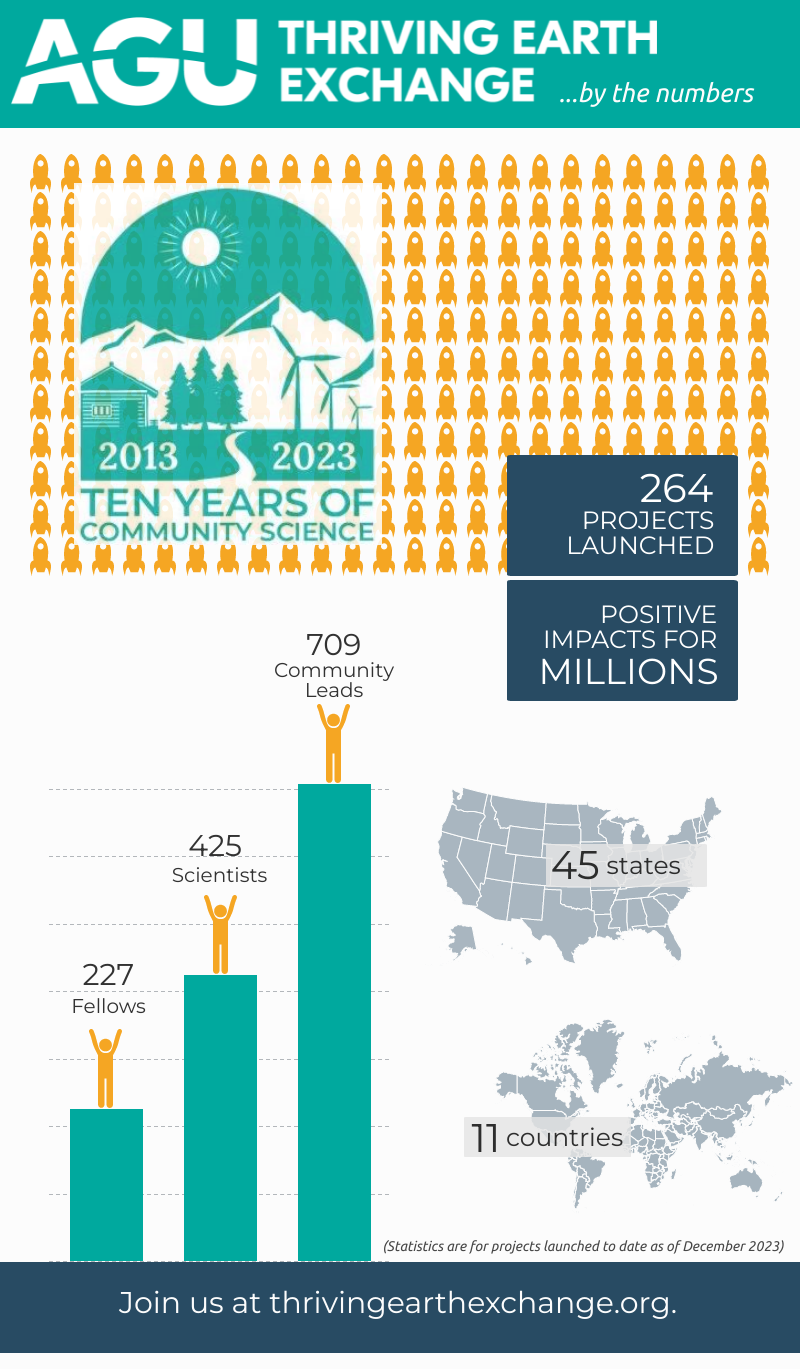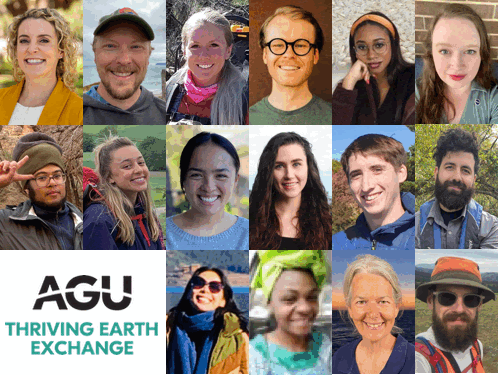2023 Thriving Earth Exchange Year in Review
2023 marked 10 years since Thriving Earth Exchange began with the bold premise that science should put communities first. Over the years, the program’s small but determined staff and leadership experimented with different models of putting this idea into practice, learning from both the successes and the failures, and growing a robust network of volunteers and partners who have advanced hundreds of community science projects around the world. Through this journey, we have shaped and sustained a broader community science movement.
As we celebrate this milestone and all that we have accomplished together, we continue to lay the groundwork for the future. In 2023, that meant two things: building up and reaching out.
- Building up: More people means more impact. This year we grew at all levels, from our team to our volunteer pool to our increased trainings and support. With a plethora of communities eager to participate and ample interest in facilitating projects from prospective Community Science Fellows, we are well positioned to foster many impactful projects in the year ahead.
- Reaching out: Through expanded global partnerships and the launch of our Regional Hubs program, we have created new channels through which a wider array of communities can benefit from community science. We also are beginning to reach and empower more Spanish-speaking frontline communities in the U.S. and abroad with multilingual resources and a dedicated Spanish-language project coordinator.

Stats included in infographic:
- 264 projects launched
- Positive impacts for millions
- 227 fellows
- 425 scientists
- 709 community leads
- 45 states
- 11 countries
*cumulative stats reflecting 10 years of Thriving Earth Exchange from 2013 through December 2023
Our Projects
Projects launched in 2023
In 2023, 48 projects were launched, growing our ongoing projects from 116 to 162 supported in a year.
March
- Braco, Jamaica: Using sargassum seaweed as an organic waste source for agricultural and community digesters
- Houston, Texas: Understanding and reducing risk: Developing impact statements, assessing risk, and determining offsite consequences for a residential neighborhood in close proximity to large, peak shaving propane facilities and their pipeline systems
- Paden City, West Virginia: Facilitating a community meeting about toxic exposure, health impacts, and the mitigation process
- Sulphur, Louisiana: What’s in our air? Assessing permitted pollution levels to determine collective impact of proposed development
- Travis County, Texas: Modeling wind patterns to inform air quality monitoring of concrete plants
- Tucson, Arizona: Educating the South Tucson community about toxic chemicals
- Wasatch County, Utah: Reclaim Mayflower Mine tailings area
- Wellsburg, West Virginia: Assessing noise pollution and air quality impacts from a natural gas compressor station
With additional project development in:
- Guayama, Puerto Rico
- Little Rock, Arkansas
- Richmond, California
July
- City of Oberlin, Ohio: Quantifying the impact (social, economic and environmental) of stormwater in the City of Oberlin and designing a sustainable solution to address it
- Carlisle, Pennsylvania
- Louis, MO
- Lake County, Illinois
- Madison, North Carolina
- Pennsylvania
- Newark, New Jersey
- Portsmouth, Virginia
- Jacksonville, Florida
- Tijuana, Baja California, Mexico
- Wailuku, Hawaii
- Clairton, PA: Assessing the health, environmental, and economic impact of coke production and transition to green steelmaking on Black communities in Clairton, PA
- Follansbee, West Virginia
October
- New Orleans, LA: Understanding the Impact of the Urban Heat Island Effect in the Hollygrove Dixon Neighborhood
- Mekelle, Tigray, Ethiopia
- Birmingham, AL
- Camp Hill, AL
- Madison, AL
- Mobile, AL
- Montgomery, AL
- Trussville, AL
- National City, CA
- Denver, CO
- Pascagoula, Mississippi
- Vieques, Puerto Rico
- McCormick, SC
- Waco, TX
- Issaquah, WA
Projects completed in 2023
Teams across the U.S. celebrated project completions this year. The City of Arcata, California is gaining new insights into local marsh dynamics in the face of sea-level rise, the community of Ottawa County, Oklahoma has a useful new interactive flood map, and those in Reidsville, Georgia have a greater understanding of the potential of green infrastructure to help mitigate flooding. A water quality report developed with residents near fracking sites in Columbus, Ohio can serve as a basis for ongoing monitoring efforts.
Our Community

Faces of Thriving Earth Exchange in 2023, including Fellows and Community Leads from cohorts launched in March, June and October.
2023 project cohorts
We were pleased to welcome 55 new Community Science Fellows and Community Leads across three cohorts in 2023. The fellows completed their project launch training and have been partnering with community leads to scope and launch projects in the U.S., Mexico, Brazil, and Jamaica.
- Spring cohort: Community Science Fellows | Community Leads
- Summer cohort: Community Science Fellows | Community Leads
- Fall cohort: Community Science Fellows |
New faces
The Thriving Earth team expanded this year to meet growing demands for engagement and coordination of fellows, communities and cohorts. We were excited to welcome Marina Cox, Britt Forsberg, Shari Rose, and Amanda Shores to our team. We also bid a fond farewell to several team members who are pursuing new endeavors, including Raj Pandya, Thriving Earth’s visionary founding director.
Collaborators active in 2023
Our collaborators are essential to our work. These outstanding organizations have helped to identify and refer communities to participate in projects, helped us develop and scale our program to support more communities, and brought additional skills and resources to projects.
- NEON
- NPS
- Anthropocene Alliance
- C2P2
- ICLEI USA
- ICLEI Global
- EPIC-n
- Future Earth
- Belmont Forum
- IAI
- ASTC
- GFOA
Our Impact
New partnerships advance community science in underserved areas
With generous support from the Gordon and Betty Moore Foundation, 2023 saw the launch of our Regional Community Science Hubs program. The program provides funding for organizations to support their adaptation of the Thriving Earth community science approach to enhance their capacity to lead locally-tailored community science projects. Our first Hubs partner, Capacity Collaborative, has been able to bring 10 communities from the Deep South and Puerto Rico into our network, expanding the reach of the Thriving Earth model into areas where we’ve had limited previous impact.
Bringing a community focus to climate discussions
Building on our long history of productive conversations around challenging topics at the interface of climate and communities, Thriving Earth was invited to participate in the first USGCRP Climate Service Forum along with strategic conversations on community-science partnerships in the leadup to the first National Climate Resilience Framework. Our work with communities around the co-benefits of air pollution and climate change mitigation was also highlighted at the United Nations Environment Assembly 6th Annual North American Consultation. Our team (and community lead, Camille Hadley) also participated in FEMA’s Civil Rights Summit 4.0, which fostered dialogue and partnerships through engagement with members of the public, advocates, community allies, and civil rights organizations, as well as FEMA’s state, local, Tribal, and territorial partners.
Bridging language barriers for more inclusive projects
With the addition of a dedicated coordinator for Spanish-language projects to our staff team, we are excited to grow our network to include more Spanish-speaking communities, organizations and partners. We now provide key project materials—from flyers to applications to training materials—in both Spanish and English for a more inclusive project recruitment and facilitation process, and have a fully bilingual website. This allows us to meet communities where they are and put their voices at the center of the work.
Amplifying community voices
Community science teams found creative ways to spread the word about the challenges communities are facing and collaborative efforts to address them. In one example, Thriving Earth staff partnered with members of the Indigenous People of the Coastal Bend in Corpus, Christi, Texas to produce a video bringing visibility to their work tackling the industrial pollution that is affecting their soil.
Several projects garnered news coverage, helping to reach a broader audience. Articles and podcasts highlighted a fracking project in Ohio, a water quality project in California, a pollinator-promoting effort in Wisconsin, and community science projects in National Parks, among others. Other communities developed videos and peer-reviewed articles to share their successes and offer lessons learned.
Our Future
As we look ahead at the new year (and our second decade!), we are excited to reach an ever more diverse array of communities and scientists through our project cohorts, expanded engagement with Spanish-speaking communities, and the launch of four Regional Community Science Hubs to set up locally-tailored community science programs. To bolster our support for Community Science Fellows and technical expert partners, we are also building out additional trainings and activities with an eye toward keeping projects productive in the middle and end stages. Stay tuned for more mid-term and end-term events to celebrate achievements and learn about outcomes!
Thank you for an amazing 2023!
